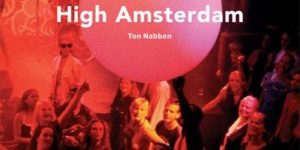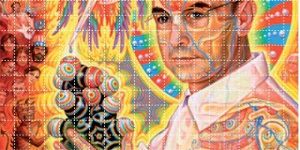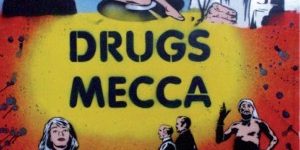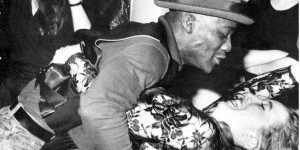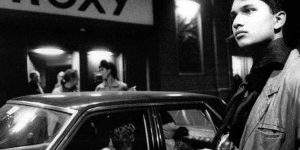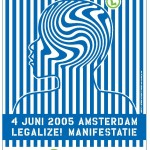High Amsterdam ~ Summary And Conclusions
No Comments yet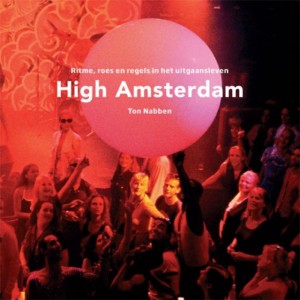 The trade in recreational drugs in Amsterdam became a good deal more complex in the 1990s when ecstasy and a range of other drugs arrived on the market. To the rhythm of house music, a new euphoric culture spread across Amsterdam nightlife like a bushfire. Policymakers and health care institutions were caught unawares by the rapidity with which ecstasy developed into the most popular illicit drug after cannabis, as well as by the acute health effects it was causing. The health authorities set up national and local-level monitoring systems to enable more prompt and appropriate responses to new or unexpected drug trends in the future. The abrupt arrival of ecstasy also triggered shock waves from a criminal justice point of view, and here, too, new measures were taken. Especially when it emerged that the Netherlands was also a leading ecstasy-producing country, the investigative machinery was aggressively expanded and reinforced by a Synthetic Drugs Unit (USD). Results were not long in coming. Drug manufacturers were arrested, production sites dismantled and large parties of drugs and precursors seized.
The trade in recreational drugs in Amsterdam became a good deal more complex in the 1990s when ecstasy and a range of other drugs arrived on the market. To the rhythm of house music, a new euphoric culture spread across Amsterdam nightlife like a bushfire. Policymakers and health care institutions were caught unawares by the rapidity with which ecstasy developed into the most popular illicit drug after cannabis, as well as by the acute health effects it was causing. The health authorities set up national and local-level monitoring systems to enable more prompt and appropriate responses to new or unexpected drug trends in the future. The abrupt arrival of ecstasy also triggered shock waves from a criminal justice point of view, and here, too, new measures were taken. Especially when it emerged that the Netherlands was also a leading ecstasy-producing country, the investigative machinery was aggressively expanded and reinforced by a Synthetic Drugs Unit (USD). Results were not long in coming. Drug manufacturers were arrested, production sites dismantled and large parties of drugs and precursors seized.
With the founding of the annual Amsterdam Antenna drugs barometer in 1993, an empirical method was implemented to systematically and verifiably document the changing lifestyles and use of recreational substances in the nightlife scenes frequented by adolescents and young adults. The idea was that drug trends (as illustrated by the rapid rise of ecstasy) usually manifest themselves in Amsterdam at an earlier stage than in the rest of the country. Antenna is a combination of three research methods: a qualitative panel study in which insiders in drug-taking scenes are interviewed twice a year about the trendsetting and trend-following networks they are part of; quantitative surveys on substance use in specific risk groups, including clubgoers; and drug prevention indicators that generate statistics on information and advice requests, drug education contacts at dance events, and tests of voluntarily submitted drugs.
The Antenna panel study was a central source of data in the study I reported in this book. Information obtained from the panel (which averaged 24 members per interview round) in the period 1994-2008 provided a continuous frame of reference for the early identification and monitoring of fresh developments in Amsterdam nightlife. By combining this qualitative information with quantitative data from Antenna and other sources (triangulation), I was able to map out a number of longer-term trends in drug use. My research question was: What developments and trends occurred in Amsterdam nightlife from the early 1990s to the late 2000s, and to what extent and in what ways did criminal justice policies and other policies and factors influence such developments?
In my attempts to identify factors that could explain the success or demise of specific drugs, Norman Zinberg’s (1984) theoretical drugset-setting model served me both as a fruitful point of departure and as an anchor. As an enhancement to Zinberg’s model, I distinguished five ‘trend dimensions’:
1. the historical, sociocultural and economic conditions under which new drug-using groups and risk groups emerge in new settings, particularly in nightlife environments (drug, set and setting);
2. the sociocultural and symbolic nightlife contexts of contemporary trendsetters and trend followers (setting);
3. translocal distribution and the supply situation in drugs markets, policing, price trends and quality (drug);
4. the nature, spread, scale of consumption and image of particular psychoactive substances in a diversified consumer market (set); and
5. policy, regulations and enforcement with respect to drugs and drug use, as well as drug users’ responses to such strategies, in particular in Amsterdam nightlife environments (drug, set and setting).
As these five dimensions illuminated very different perspectives in time and space within the domain of drugs, I expanded upon them in separate chapters following a theoretical exploration (chapter 2) and an explanation of the panel method (chapter 3). Amsterdam nightlife up to and including the ‘house music revolution’ of 1988 was recounted in a trilogy (chapters 4, 5 and 6), whose common theme was the successive youth cultures that rocked the city in the decades from the 1960s onwards against the background of a shifting Zeitgeist. The ‘new’ Amsterdam nightlife of 1994-2008 was depicted by highlighting trendsetters and trend followers. The drugs market of the same period was explored in chapter 7, with primary focuses on efforts to combat the drugs trade and on price trends and purity levels of six drugs: ecstasy, cocaine, amphetamine, GHB, laughing gas and ketamine. Those substances were examined in greater detail in chapters 8, 9, 10 and 11, including interpretations of the symbolic and other meanings that were ascribed to the drugs in trendsetting and trend-following nightlife environments. Finally, in chapter 12, I portrayed the entire nightlife scene as a semi-autonomous field of social forces in which the interests of rulemakers and rule enforcers may clash with the interests of drug users and other social actors. The Dutch government’s transition from a pragmatic drugs policy in the 1990s to a more normative, punitive policy after the turn of the century was a continuous strand in this chapter. I considered in particular whether and how the more stringent policies might have affected the nature and scale of drug use.
Theoretical explorations
Studies of deviance conducted in the United States after the 1950s often focused on the particular significance of music, drugs and other cultural manifestations that conflicted with the mainstream taste of authorities and public opinion. In the 1970s and 1980s, the fulcrum of social science research was in the United Kingdom, where researchers concentrated largely on working-class youth and their leisure time, with an almost obsessive focus on the ritual resistance of spectacular youth styles. Studies also appeared on moral panics, media influence and the role of ‘moral entrepreneurs’ and authorities. Characteristic of many studies was that the ‘subversive’ street cultures were described with theoretical detachment or even with an ideological tinge. After the spread of ecstasy and electronic dance music, researchers in the 1990s partly reverted to the classical US urban ethnography.
Studies on the club and rave culture increasingly focused on distinctive practices either inside or outside the mainstream. In particular, the cultural significance of nightlife drugs and music had a prominent place in these studies. Another topic was the actual or presumed transformation of subcultures into ‘post-subcultures’. Quantitative studies concentrated mainly on drug trends and the postulated normalisation of drug use. According to the researchers, the unbridled consumerism of the 1990s youth gave rise to new forms of risk behaviour, particularly in nocturnal milieus, which were promptly hyped up by the media. In this tradition, cultural criminology encompasses a broad spectrum of research disciplines that probe into issues such as the popularisation of crime, the widespread culture of carnivalesque sensation- and pleasure-seeking behaviour, the strong identification of young people with a norm-violating or even deviant consumption of visual culture, and transgressive nightlife subcultures.
These new studies on risk-taking hedonistic behaviour ran almost completely counter to the theory of Howard Becker (1963), who traced step by step the social learning process through which marijuana use was initiated and continued. Like Zinberg, Becker developed his theory in an era when youth scenes and drug use had a different significance and were more self-contained than today’s more fluid networks as manifested in the Amsterdam panel study. Modern studies in cultural criminology therefore throw a very different light on drug use. Some criminologists view drug-taking as a (mostly temporary) escape from the daily humdrum, whilst others see it as a reaction to an unstable, fast-changing world where, in the face of weakened social control, the urge to experience sensation and excess is a constant source of titillation. In Becker’s ideal-typical model, ‘irrational’ euphoria-seeking behaviour in the peer group would primarily be labelled as a kind of ‘drug abuse’. But the collective tripping on drugs seen since the 1990s was a far broader-scale phenomenon than would be expected on the basis of Becker’s findings. Although Becker’s step of ‘learning the technique’ still took place in group settings, the learning process in the modern spectrum of drug highs was far more complex than that for the ‘monodrug use’ in Becker’s study. Because his social learning theory could not decisively explain the euphoric behaviour of modern drug users, I proposed to distinguish today’s euphoria seekers into the sensible ‘euphoric artists’ and the destructive ‘euphoric bunglers’.
Rebellious youth cultures and the explosive growth of nightlife Amsterdam nightlife has an illustrious history. It can look back on several ‘golden ages’, starting more than a century ago, when industrialisation, urbanisation and burgeoning prosperity spawned a diversified range of amusement venues around 1890. Soon, however, the contemporary crusades waged by ‘moral entrepreneurs’ against the degenerative excesses of poverty, drink and prostitution had indirect consequences for the colourful Amsterdam nightlife, putting a temporary end to its first heyday. The interbellum (1919-1940) saw a renascence of nightlife in a choice array of new bars, music venues, theatres, restaurants and cinemas in the Leidseplein and Rembrandtplein neighbourhoods. This time, the sophisticated goings-on were viewed suspiciously by city authorities. Particular scrutiny was directed at the popular, but morally suspect, ‘Negro musicians’ in the dance halls. Some venues received mayoral orders to hire no more black entertainers and waiters. When the persuasion grew in the 1930s that dancing did not necessarily go hand in hand with ‘immoral’ practices, the municipal licensing policies were relaxed.
After the Second World War, new dance venues sprang up, and jazz was equated no longer with ‘animalistic’ instincts and eroticism, but with freedom, individualism and vitality. Dancing came to be seen as an excellent means to smooth relations between the sexes; it also embodied an element of escapism as a reaction to the postwar chaos. Although the smell of marijuana began wafting through the tiny jazz clubs during the 1950s, drug use did not really become enmeshed with nightlife until a decade later. The emergence of the 1960s drugs scene was closely tied to demographic, economic and sociocultural developments. In the growing prosperity, young people now for the first time had their own money, much of which they spent on the products of the emergent fashion and music industries. The new youth culture distinguished itself through its rebelliousness and its vocal, socially radical stances that were utterly at odds with the views of older generations and the establishment. Music was the binding force for highly varied groups of young people, whose voices were growing louder both in nightlife venues and on the streets of the city centre.
In this new social context, youth were experimenting not just with cannabis, but also with LSD, opium and amphetamine. The drugs were taken as recreational substances, as expressions of protest, or as an aid in existentialist or spiritual quests for the purpose and meaning of life. Fuelled by the rapid spread of drugs in the 1960s and 1970s, new youth scenes appeared around Leidseplein, Rembrandtplein, Dam Square and Vondelpark. When, some years later, the first warnings were heard of a growing ‘drug problem’, cocaine and ecstasy were still unknown, but heroin and amphetamine had already begun their advance in deviant subcultures, alongside cannabis and LSD. The consumer market for drugs bifurcated in the course of the 1970s and 1980s into recreational and problem drug scenes. In the politically turbulent 1980s, the carefree discotheque culture of the previous decade was overshadowed by the more vocal punk and squatters’ cultures.
Because surprisingly little empirical data was available on recreational drug use in Amsterdam between 1976 and 1988, I drew information from anecdotal reports in order to bridge over the period until the ‘house music revolution’ of 1988. The house revolution coincided with a period of economic and cultural prosperity. Within youth culture, it signalled the turning point from a politically inspired generation (the Lost Generation) to an apolitical partying generation (Generation X). The rise and spread of house music and ecstasy may be seen as a synthesis of pharmacological, technological and subcultural innovations.
The developments from 1988 to 1994 evolved in three successive phases: an underground phase reflected in a concentrated amalgam of spontaneous nightlife cultures; a transitional phase (between underground and mainstreaming) in which house culture and ecstasy diffused across a variety of nightlife environments; and the mainstreaming and professionalisation of house culture, marking the start of an advancing scale expansion and massification from the mid -1990s. The precipitous growth of the party venues and the partying masses thrust them into an unrelenting media spotlight; the initially benign perceptions of the drug ecstasy took a turn for the worse as the numbers of health incidents increased. Calls for regulation compelled local government to impose stricter new rules on the organisers of dance events. All the while, sponsors were gaining more influence over commercial dance events. House music sparked a renaissance in Amsterdam nightlife, which underwent an explosive expansion from a mere handful of clubs in the early 1990s to a flourishing industry with dozens of clubs, lounges, dance bars and ad hoc partying venues.
The new nightlife
Throughout the years, the Antenna panel study has covered three age groups in nightlife generations: people in their early twenties (age 20-24), those in their late twenties (age 25-29) and the over-30 age group. The average age in the networks represented by the panel members was about 25. Especially at in-crowd events, a typical Amsterdam party would be attended by people in their 20s, 30s and sometimes 40s. Mainstream club nights would mainly play host to beginning nightlifers aged 20 to 24, some of whom would develop into trendsetters. The trendsetting set were mainly above 25. The youngest club generation identified itself most strongly with newer music styles and the associated scenes. Urban fans were generally younger than their dance counterparts. Many nightlifers in the panel networks went to clubs at least twice a month, and the most fanatical ones went several times a week. Attendance at dance events and festivals swelled during the summer. Ethnic Dutch clubgoers were more likely to also frequent bars and dance events than ethnic minority clubgoers. The genuine ravers were the least likely to patronise nightclubs, especially if they were into more extreme music scenes like hardcore, hardstyle, tekno of psytrance.
Compared to the dance music lovers, the more ethnically mixed urban music set had less or no experience with illicit drugs, although the trendsetters were more amenable to experimenting with ecstasy. They sometimes switched over to other, more dance-oriented nightlife niches. The dance set remained predominantly ‘white’. The most diverse ethnic blends were found in small clubs that played eclectic music selections. The rise of urban music led to a major ethnic shift in the club scene, which for years had been overwhelmingly white. A growing influx of young women also brought on changes in the formerly male-dominated nightlife scene; women claimed their own space, acted assertively and even dared to behave provocatively.
Young males were now strongly in the majority only at the heavier events. The youngest gay and lesbian generations (in their early 20s) seemed more inclined to avoid specifically gay events and to increasingly move in straight scenes.
The ‘feminisation’ of Amsterdam nightlife was also reflected in four successive Antenna surveys of clubgoers (1995, 1998, 2003 and 2008); the quantitative surveys in Antenna are designed to uncover new developments and changes in new generations of clubgoers. The median age, which was 23 in 1995, reverted to that level again in 2008 after a temporary rise around the millennium. A doubling in the percentage of ethnic minority clubgoers from 2003 to 2008 was largely explainable by the increasing number of urban club nights. The higher percentages of students polled by the surveys coincided with growth in the Amsterdam student population, as well as with the massification and mainstreaming of nightlife. At the same time, the numbers of frequent nightlifers (at least four club visits in the past month) declined and the preferences for types of venues changed drastically. While clubs and bars remained popular, raves attracted significantly fewer visitors after a peak in the late 1990s. Home parties steadily gained ground, as did concerts to some extent.
Five profiles of trendsetters and three broad nightlife trends On the basis of the panel study, I distinguished five trendsetter profiles, based on differential articulations of nightlife activities, music, dancing, body culture and substance use. The recreationalists were the least active euphoria seekers and also the least pronounced in terms of stylisation, musical tastes and nightlife preferences. The creatives were well educated, successful in society, individualistic and eclectic, but also not very outspoken in their musical tastes. The alternatives were more closely tied to their nightlife scenes (both white and black subcultures), were often averse to commercialism, and prided themselves on their refined, counterculturally inspired musical knowledge. The sensualists were the most hedonistically and erotically involved and were less single-minded in their musical preferences. The psychonauts identified themselves as ‘chemical gourmets’ and as offspring of the hippie culture with their wide experience in mind-expanding drugs, their predilection for small-scale settings and their use of drugs in ritualised contexts.
After the turn of the century, three broad trends shaped Amsterdam nightlife into its current form. Upgrading stood for the process of chicification and elitisation fuelled by the economic boom. A larger segment of nightlife was transformed into exclusive partying zones featuring new hotspots for in-crowd entertainment, stardom and consumptive luxury, where prominent club elites and VIP castes lavishly celebrated their leisure time. Upperground represented the expanding segment of alternative clubs that nestled into the heart of the mainstream after the demise of the underground milieu, generating a critical partying preserve that was averse to ostentation and bling, while striving more to innovation with a seamy countercultural fringe. Urban was at once a reflection of the multicultural process and an emergence of non-electronic music styles. The growing influence of urban music forced a breach in the white nightlife bastions; at the same time, it symbolised the ‘new sobriety’ in the nightlife domain.
The Amsterdam drugs market
From the early 1990s, about 35 different illicit substances were available on the Amsterdam drugs market. My focus was on the drugs that had a significant impact in nightlife scenes for briefer or longer periods – three stimulants: ecstasy, cocaine and amphetamine; and three anaesthetics: nitrous oxide or laughing gas, GHB and ketamine. While drug use mounted from late 1980s to the late 1990s, the prices tended to decline on the whole. Lower drug prices did not automatically induce higher consumption, as the demand for a drug also depends on its effects and its image – the stronger the ‘pleasure factor’, the greater the likelihood that consumers will want to try a drug. In a promotional sense, then, the choice of the word ecstasy as a ‘brand name’ for MDMA was a gold strike.
Alongside the clandestine higher-level drugs market, there is an ‘open’ market at the consumer level where contacts between individuals and networks are cultivated on a basis of mutual trust. The retail-level supply of drugs is represented by monodealers and polydealers, and these can be distinguished into home-based dealers (the ‘shoppers’ market’) and courier dealers (the ‘delivery market’). For each of the six selected drugs, I examined fluctuations in availability, purity and price.
The consumer-level market dynamic of cocaine intensified as ‘pill fatigue’ set in amongst the initial subgeneration of ecstasy trendsetters, as the status of ecstasy dealers declined (not least as a consequence of the low prices) and as the mobile phone made it easier for clients and dealers to locate one another. The consumption of cocaine peaked around the turn of the century, as the hospitality industry boomed and the alcohol industry ran in top gear. A ten-year doubling of the cocaine kilo price that began in the late 1990s was not followed by any appreciable price rise for consumers, while the purity also remained relatively stable.
Ecstasy, after a brief quality dip in 1997, was available for ten years thereafter at low prices and reliable quality levels. Then a sudden period of scarcity set in, inferior pills appeared on the market and consumers had more trouble finding ‘good’ ecstasy. The market seemed to be recovering by the autumn of 2009, just as in 1997, but the price was now somewhat higher.
The amphetamine market began shrinking in the late 1990s, simultaneously with the decline of gabber culture. Scarcity prevailed in 1999-2001 and quality was below par, causing a good many amphetamine users to switch to cocaine. Although the market later recovered, and began to grow again in the late 2000s, the retail market still remained smaller than it was in the 1990s.
The market for anaesthetic drugs was relatively new. Laughing gas, GHB and ketamine developed a stronger presence in private settings from the mid-1990s. From the mid-2000s, GHB and ketamine were increasingly taken in nightlife settings as well. There were indications that the ecstasy shortage of 2008-2009 led newer and older users to experiment more with GHB, as well as with laughing gas (which had experienced an earlier peak in 1997-1998) and to a lesser extent with ketamine. The prices of GHB and ketamine fell in the course of the 2000s, sometimes sharply.
Trend perspectives of drug users, drug markets and nightlife
The fourth explanatory dimension of drug trends (the nature, spread, scale of consumption and image of individual drugs) was explored from the differential perspectives of users, drug markets and nightlife scenes. The analysis was based on data from the panel study in combination with data from the club surveys of 1995, 1998, 2003 and 2008. The period up to 2008 could roughly be divided into three 5-year cycles which were characterised by successive trendsetting subgenerations comprised of various types of drug users (recreationalists, creatives, alternatives, sensualists and psychonauts). Although the latter groups could be at different stages of their drug-using careers, all five of them may be viewed as trendsetting for nightlife behaviour in general as well as for recreational substance use in particular. In some cases, ecstasy and cocaine (and to a lesser extent other drugs as well) were taken within the same panel networks, often in combination with alcohol and/or cannabis.
Ecstasy
During the 1990s, ecstasy began to take the fancy of more and more nightlife cultures (vertical expansion); in the networks within them, more and more people were taking ecstasy (horizontal expansion). After the turn of the century, fewer groups were receptive to ecstasy (vertical contraction), and also the frequency of use diminished within user networks (horizontal contraction).
Despite adverse user experiences with ecstasy in the 1990s, the general perception of the drug initially remained positive. It was not until after the ‘tipping point’ in 2001 – the transition from the mainstream to the post-rave phase – that ecstasy began losing ground across practically the whole nightlife front. This also formed the watershed between the previous massification of nightlife (scale expansion) and the migration of trendsetters into smaller, often exclusive venues (scale contraction). It coincided with a growing desire for differentiation (eclecticism). The period after 2003 was also characterised by what has been called a ‘new sobriety’. The changing attitudes towards ecstasy and the changing perceptions of the drug (set factors) are primarily explainable as consequences of a significant (actual or perceived) increase in subacute mental health problems. The former image of ecstasy as a ‘soft drug’ that could be indulged in without limit and with no chance of addiction was no longer sacrosanct. Because the positive effects of ecstasy tended to diminish with repeated use, the desire to take it decreased commensurately.
The falling ecstasy prices did not lead to more consumption of the drug; quite the contrary, the use of ecstasy declined from 2001 onwards. Although in some cases poor-quality pills might have prompted people to stop doing drugs or to switch to other substances, the purity levels of ecstasy long had little influence on decisions to quit. From the perspective of nightlife settings, the declining ecstasy use did correspond to certain changes. Although scale expansion had given rise to a flourishing dance industry, it had also sown the seeds of deterioration, as seen in a rise in health incidents. Clubs responded by upgrading and by cracking down on drug use, thereby attracting a more ‘sober’ clientele and (partly through the influence of urban music) further eroding the ecstasy-compatible mood of the establishments. Post-millennium subgenerations were also less fervid sensation seekers.
Cocaine
The originally quite segregated cocaine and ecstasy milieus began to converge from the mid-1990s and intersected around 2006. Cocaine was hitting the spot in a greater diversity of nightlife cultures (vertical expansion), and more people began sniffing within those networks (horizontal expansion). After 2006, the prevalence of cocaine use remained rather steady. Both cocaine and ecstasy were being taken in many panel networks, with the relative preference for one or the other often depending on the setting. Age and lifestyle were also key factors in the continuation of cocaine use after initiation. Cocaine was less subculturally defined than amphetamine or ecstasy, making it accessible to a broad and varied public (low- to high-income, students to executives). Cocaine was also less strongly associated with a style of music than other drugs, but it was more closely linked to certain lifestyles. People who still actively frequented nightlife venues after age 25 tended to do drugs more regularly and intensively – and to prefer cocaine above ecstasy.
The growing popularity of cocaine, which had renewed its spread after a pause since the 1980s, ran parallel to the expansion of the nightlife and alcohol industries that occurred in the run-up to the new millennium. By the end of the 20th century, the booming economy had propelled cocaine consumption to great heights. Cocaine users reported experiencing great pleasure from snorting cocaine, both on a night out and in private settings. Cocaine was more likely to be taken in small groups, whereas ecstasy was associated with large dance events and clubs. The sniffing ritual was said to deepen the mood of intimate conviviality. The social ritual of cocaine use was less setting-dependent than that of ecstasy, and the high was easier to camouflage. This agreeable, performance-enhancing, creativity-inspiring sensation was perfectly attuned to the new competitive spirit of the times. Although the 1980s image of cocaine as a ‘problem’ drug had now swung back to neutral or positive, cocaine users (and especially the persistent ones) developed a love-hate relationship with cocaine.
A number of changes affecting the Amsterdam drugs market in the late 1990s fanned the increasing use of cocaine. The low price of ecstasy made it more lucrative for dealers to push cocaine. The contamination of the ecstasy supply around 1997 coincided with a record low cocaine price. And the communication between drug dealers and cocaine sniffers was simplified by the new mobile phone networks. Remarkably, cocaine maintained a reputation of having ‘reliable quality’, even though everyone knew it was cut with other substances.
In terms of the nightlife perspective, the upgrading of the clubs and lounges and the growing popularity of home parties also contributed to the upward revaluation of cocaine.
Amphetamine
From the mid-1990s, the cocaine and amphetamine milieus in Amsterdam steadily drifted apart. Amphetamine, or speed, appealed mainly to trendsetters in alternative scenes (narrow vertical expansion), where the use of it spread to other nightlifers (horizontal expansion). Most networks preferred either cocaine or ecstasy, in each case followed by amphetamine, which almost faded into obscurity after the demise of gabber parties in the late 1990s. The peak periods of amphetamine reflected the subcultural rise of gabber or hardcore music (1993-1998) and that of minimal music (2003-2008). Setting, age and lifestyle were significant factors. The experimental use of amphetamine crystallised in young party networks (aged 20-25). Those who continued taking part in nightlife after that age usually switched sooner or later to cocaine. The status of amphetamine has been that of a controversial, largely subcultural drug; contemporary Amsterdam user groups, as well as solo users, often identified themselves as alternative, radical and artistic. Typical speed users felt a repugnance to chic clubs and swaggering coke snorters. Whereas ecstasy and cocaine were widely perceived as rather user-friendly drugs, amphetamine remained a drug of ‘self-conscious outsiders’ by virtue of its rough image, low status and cheap, protracted high. Speed was a B-rated drug.
The changing conditions in the drugs market around the turn of the century also had their impact on the use of amphetamine. At a time when the cocaine market had begun to expand and the ecstasy market was flooded with cheap, good-quality pills after the dip of 1997, severe scarcity prevailed on the amphetamine market after the gabber era. Some networks switched to cocaine. Compared to the ecstasy and cocaine markets, the amphetamine market remained smaller and less seductive. Viewed from the nightlife perspective, the upgrading of venues also played a part in the declining amphetamine use, given the drug’s exceptional sensitivity to subcultural trends. As a rebellious, recalcitrant stimulant that thrives in shady places, amphetamine was rediscovered from time to time by subcultures that thumbed their nose at the mainstream taste conventions in Amsterdam nightlife. In the late 2000s, a new leaning towards radicalisation of music styles and drug use was evident in certain niches within the countercultural dance scene – and so was a rebounding popularity of amphetamine.
Anaesthetics
The advent of the anaesthetics laughing gas (nitrous oxide), GHB and ketamine in the 1990s also signalled the introduction of two yet unknown drug-taking techniques into Amsterdam nightlife. Laughing gas, which appeared on the market in the mid-1990s, was served in balloons filled from industrial gas canisters, often near the dance floor. GHB was sold and taken in liquid form. After the turn of the century, GHB remained the most popular anaesthetic drug, and in the late 2000s it was equally popular to amphetamine, according to the panel study. The anaesthetic drugs were showing a light upward trend towards the end of the decade.
Laughing gas sparked a craze when it was introduced into underground scenes, and it soon moved on to clubs and festivals. The spread of GHB began after the laughing gas peak and occurred mostly amongst experienced creatives, psychonauts and sensualists. Although it soon acquired some notoriety as an ‘accident drug’ and ‘rape drug’, GHB also tickled people’s curiosity. It was thought to be a non-toxic, endogenous body substance that acted as a mild aphrodisiac and did not cause hangovers. Clubgoers were quick to take GHB in combination with ecstasy. The relatively high numbers of incidents provoked considerable ambivalence in nightlife circles. Many users still valued the feeling of placidity and mild euphoria. This suggests that GHB could develop in due time from a secondary to a first-choice drug for some users after a career of stimulant use.
A historical line leads from ketamine to countercultural nightlife settings. Initially, the use of ketamine was confined to isolated scenes (alternatives, psychonauts), but it spread to the upperground after the mid-2000s. This ‘mildly’ psychedelic substance has a high cult factor due to its bizarre rush effects. Similarly to users of GHB, ketamine users are more likely to experiment with other (sometimes exotic) substances and take them in combination with ketamine to either neutralise or intensify their psychedelic high.
The arrival of anaesthetic drugs on the Amsterdam market in the mid-1990s occurred at a time when party cultures, especially the countercultural ones, were keenly exploring new euphoric dimensions like the ‘cosmic’ laughing gas buzz, the ‘sensuous’ GHB high and the ‘psychedelic’ ketamine rush. In the beginning, laughing gas vendors could peddle their wares undisturbed at parties and raves. When the number of health incidents began to grow in tandem with the number of vending sites, the police stepped in. Event organisers and laughing gas vendors were enjoined to cease and desist from selling the drug, and wholesalers were prohibited from delivering to unregistered clients. The measures quickly bore fruit. GHB was initially promoted by the smartshop sector as a legal alternative to ecstasy (‘liquid ecstasy’) at the time of the ‘ecstasy dip’ around 1997. Prompted by health incidents, the authorities ordered the smartshops to halt the sale of the drug. From the turn of the millennium, ingredients and do-it-yourself kits for making your own GHB were being offered on the Internet. GHB was often manufactured in the home and distributed within circles of friends, often on a non-commercial basis. Ketamine became better known after travellers brought it from India and introduced it into the Amsterdam underground scene. In the course of the 2000s, it made a breakthrough into mainstream scenes. The consumer-level prices of ketamine as well as of GHB plunged by half. From the nightlife perspective, the growing interest in underground and upperground scenes, afterparties, erotic parties and home gatherings gave impetus to the spread of laughing gas, ketamine and GHB.
Pragmatic drug policies under pressure
The drugs policies in the Netherlands were long known as pragmatic and tolerant, but they came under increasing pressure in the first decade of the 21st century. At the local level, this expressed itself in more rigorous zero tolerance policies. Chapter 12 analysed developments in the Amsterdam drug users’ market by considering the nightlife environment first of all as a semi-autonomous force field between the (sometimes outlandish) sociocultural practices in the nocturnal economy and government control through legislation and regulation. Three important factors – production, consumption and regulation – reflected and structured the dynamic social, cultural, legal and economic force field between the consumers and producers on one side and the rules and enforcement of public order and safety on the other – a field in which their differing and concurring interests met and interacted.
Three broader societal trends also had their repercussions in Amsterdam nightlife. First, after the turn of the century, the previous culture of toleration was increasingly superseded by policies that put the emphasis not on disease prevention and health promotion, but on more stringent, normative crime control. Second, Amsterdam experienced a transition from an industrial to a service economy; this was bolstered by proactive local policies of city marketing and city branding, coupled with a keen focus on public safety and control. The third development was the ‘safety doctrine’ that rose to the top of the local government agenda after a series of incidents inside and outside the burgeoning nightlife environment. One resulting measure was to confer more responsibilities on the fire department and the municipal health service for approving dance event permits. At the same time, police and prosecution were urging sterner punitive action to gain control over drug dealing and drug use in nightlife. The goal was to subdue the ‘partying madness’, using criminal sanctions if need be. The initial focus was on the club scene, including more rigorous body searches by door staff and more raids led by the Amsterdam police department’s Horeca Interventie Team (HIT). The authorities then turned to the dance events. Administrative powers were expanded and local byelaws were assigned more weight alongside the national Opium Act in order to crack down on the dealing, possession and ‘public use’ of drugs. Police were more inclined to act against persons who were ‘conspicuously under the influence’. The policy shift was revealing, in that the use of ecstasy, as well as the occurrence of drugrelated health problems, had already been diminishing for some time before the zero tolerance policy was introduced. The more repressive approach was motivated not so much by ‘internal’ factors (such as public disorder, large-scale drug dealing or intolerable risk levels at events or nightclubs), but more by an intensifying focus on public order and safety and a desire to heighten the authorities’ visibility and proactive law enforcement efforts.
Does a zero tolerance policy deter drug use? Or is it more likely to have a ‘waterbed effect’, shifting the problem elsewhere? To address these questions, I examined how drug users and drug dealers responded to zero tolerance, whether identifiable changes or trends in drug use occurred, and whether such developments could be attributed to zero tolerance.
First, in spite of the many arrests and confiscations of mostly small quantities of drugs, the intended goal of drug-free events was not achieved by any means. This is partly explainable by the limited search powers of private security staff and by the need for both police and event organisers to deploy far more staff in order to thoroughly bodysearch all partygoers. Even leaving aside the prohibitive costs of the latter operation, it would raise formidable problems with maintaining order.
Second, what one saw in practice was that the stricter the policing, the more drugs that were taken before the start of an event. A large majority of partygoers reported obtaining their drugs prior to the event (usually more via sharing than dealing) and anticipating the searches by hiding the drugs better and/or by taking them beforehand.
Third, the more stringent searches and police raids in clubs that began in the late 1990s prompted club owners to take more measures aimed at curbing drug use. Partly on the basis of new legislation, a ‘big cleanup’ was carried out in bouncers’ circles and tighter door checks were introduced. Drug drop safes were installed and cannabis was more often banned from clubs.
Fourth, the process of ‘upgrading’ occurred in nightlife, coinciding with the advent of urban music, whose followers had considerably less interest in drugs. The ‘new sobriety’ gained more sway and the use of ecstasy declined sharply. Trendsetters switched to cocaine, which was more suited for use in bars, at home or at small parties. It would be difficult to determine whether such trends in drug use were causally connected to repressive measures.
Last of all, product substitution regularly took place in the Amsterdam drug market as a result of modified legislation or successful enforcement measures. Often this was a temporary phenomenon, since by no means all ‘new’ drugs found wide resonance. In some cases, though, successes in combating one drug did give an impetus to the spread of another, as happened when the use of GHB increased after the ecstasy shortage of 2008-2009. Here, too, it would be hard to show a causal connection.
The drugs market in Amsterdam nightlife was highly dynamic in the period from 1994 to 2008. A number of different factors fuelled this dynamism, making it extra difficult to assess any influence that changes in criminal law policy might have had. Even so, it seems quite plausible that the clampdowns in Amsterdam nightlife contributed over the longer term to a moderation in drug consumption as well as to a shifting of drug use into private settings. In the latter case, the clampdowns would have also led to changes in the nature of drug use, such as a new interest in experimenting with ketamine or sniffing cocaine instead of taking ecstasy.
You May Also Like
Comments
Leave a Reply


